





Painting-Lifehack 1: Simply paint on the labelling

To apply the name of the yacht to the stern, we do not use foil but paint the lettering on. To do this, the surface is first generously covered with gold tape, then the letters are cut out of the masked surface using a scalpel and a previously printed paper template. The cut-out letters and the template are removed and the surface is painted over with two to three coats of varnish. After removing the masking, the lettering remains. This process does not incur any additional costs and the materials already available for painting the boat can be used. You also have a free choice of colour and design, the paper templates can be printed out using a computer and the method can also be used for any other motifs.
Reinhard Otto, Berne/Switzerland
Paint-Lifehack 2: Arbitrating with the roller

I use standard foam rollers for painting. Experience has shown that bubbles always appear on the paint surface, resulting in a so-called orange peel effect. This can be avoided by re-sanding. Instead of using a special brush, I use the foam roller itself, which is attached by means of a hole in the centre of the axle and an inserted nail or wire pin, which I pull lightly over the surface without applying pressure. This not only removes bubbles, but also the finest dust particles.
Gregor Monkenbusch, Soest
Painting lifehack 3: Wrapping instead of gluing

Anyone who has varnished wooden parts on board or sails a wooden boat like us will be familiar with the problem of the recurring varnishing work, whereby the clean masking of the fittings takes up most of the time and effort. Instead of this annoying task, we have been wrapping them with simple household cling film for several years now. Both covering and removing it is much quicker than it would be with masking tape. Especially with larger components such as cleats, the film also offers the advantage that the entire fitting is protected from paint. You don't have to be so careful with the paintbrush.
Dorothea Drews, by e-mail
Painting lifehack 4: This keeps the brush fresh for longer

When painting, we often use various brushes and have to apply several coats over several days. To avoid having to clean the brushes, we put them in a preserving jar with turpentine substitute and put a disposable glove over them. This ensures that the jar is airtight, the brushes do not dry out and are ready for immediate use. We also put disposable gloves over the paint tins after closing them so that they don't dry out so quickly.
Viktor Schacht, by e-mail
Do you have any advice for other sailors?
We will honour the publication of your lifehack with 50 euros. Please add photos or sketches. We also need your address so that we can send you a crossed cheque.
Submissions to: Editorial office YACHT, Gänsemarkt 24, 20354 Hamburg or: mail@yacht.de
